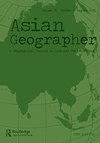Assessing the dynamic relationship among land use pattern and land surface temperature: A spatial regression approach
IF 2.2
Q2 GEOGRAPHY
引用次数: 27
Abstract
ABSTRACT Drastic changes in land use pattern in recent times has translated into severe alteration of urban surface temperatures, whereby the increase in impervious surfaces results in modification of the thermal structure of the city and consequently leads to the problem of Urban Heat Island. Conversely, creation of green surface within the city reduces the temperature and forms a cooling effect. The present study investigates the impact of the shape, pattern, and configuration of the two dominant land use/land cover classes (built-up and green surface) on the Land Surface Temperature (LST) of Hyderabad city. Different class-level landscape metrics at neighborhood level have been employed to evaluate the spatial variation of LST. Significant Moran’s I cluster value indicates spatial dependencies of landscape metrics and LST. The local Geographical Weightage Regression (GWR) model has also been executed to examine the relative importance of land use pattern on LST. Results reveal that during 2002 and 2015, the increasing fragmentation of built-up and LSI have positively influenced the LST, whereas, urban green surface, the PLAND, and IJI have negatively affected the LST. The estimated LST is found to be highly sensitive to the configuration and changes in land-use pattern. The spatial regression result suggests that with the expansion of built-up in the neighborhood, there is a discernible increase in the LST. Similarly, fragmented green cover reduces the neighboring temperature. The outcome of this study may enable planners to obtain insight into where urban management and green surface planning is necessary for mitigating the surface temperature.评估土地利用模式与地表温度之间的动态关系:一种空间回归方法
近年来,土地利用模式的剧烈变化导致城市地表温度的剧烈变化,不透水地表的增加导致城市热结构的改变,从而导致城市热岛问题。相反,在城市中创造绿色表面可以降低温度并形成冷却效果。本文研究了海得拉巴市两种主要土地利用/土地覆盖类型(建筑用地和绿地用地)的形态、格局和配置对地表温度的影响。采用邻域水平上的不同类级景观指标评价地表温度的空间变化。显著的Moran’s I聚类值反映了景观指标与地表温度的空间依赖性。利用局部地理权重回归(GWR)模型分析了土地利用方式对地表温度的影响。结果表明:2002 - 2015年,建成区破碎化程度的增加对地表温度有正向影响,而城市绿地面积、耕地面积和综合用地对地表温度有负向影响。估算的地表温度对土地利用格局的配置和变化高度敏感。空间回归结果表明,随着周边建成区的扩大,地表温度有明显的增加。同样,破碎的绿色覆盖降低了邻近的温度。这项研究的结果可能使规划者能够深入了解城市管理和绿色地表规划对于降低地表温度是必要的。
本文章由计算机程序翻译,如有差异,请以英文原文为准。
求助全文
约1分钟内获得全文
求助全文
来源期刊

Asian Geographer
GEOGRAPHY-
CiteScore
3.30
自引率
0.00%
发文量
7
期刊介绍:
Asian Geographer disseminates knowledge about geographical problems and issues focusing on Asia and the Pacific Rim. Papers dealing with other regions should have a linkage to Asia and the Pacific Rim. Original and timely articles dealing with any field of physical or human geographical inquiries and methodologies will be considered for publication. We welcome, for example, submissions on people-environment interactions, urban and regional development, transport and large infrastructure, migration, natural disasters and their management, environment and energy issues. While the focus of the journal is placed on original research articles, review papers as well as viewpoints and research notes under the category of “Asian Geography in Brief” are also considered. Review papers should critically and constructively analyse the current state of understanding on geographical and planning topics in Asia. The ‘Asian Geography in Brief’ section welcomes submissions of applied geographical and planning research about Asia. The section aims to showcase (1) the diverse geography and planning of Asia; and (2) the diverse geographical and planning research about Asia. The journal will also publish special issues on particular themes or areas. Book reviews can be included from time to time.
 求助内容:
求助内容: 应助结果提醒方式:
应助结果提醒方式:


